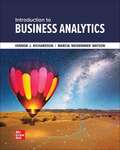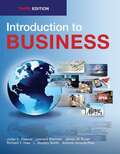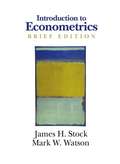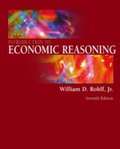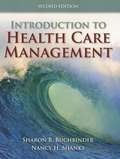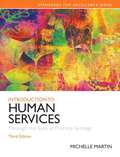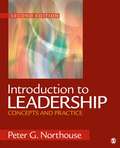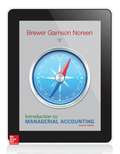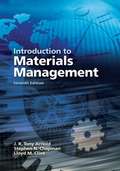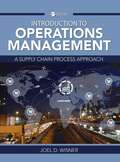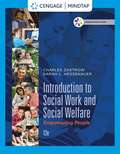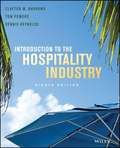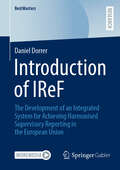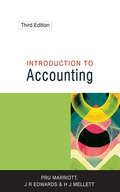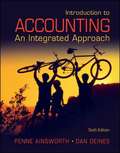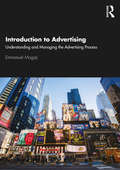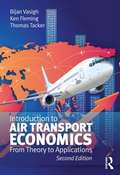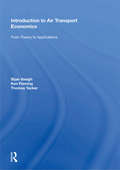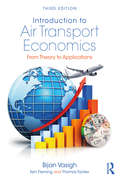- Table View
- List View
Introducing the Euro as Legal Tender--Benefits and Costs of Eurorization for Cape Verde
by Patrick ImamA report from the International Monetary Fund.
Introduction (The Strategy Map as a Visual Representation of Organizational Strategy)
by Robert S. Kaplan David P. NortonAn organization's strategy describes how it intends to create value for its shareholders, customers, and citizens. If an organization's intangible assets represent more than 75% of its value, then its strategy formulation and execution need to explicitly address the mobilization and alignment of intangible assets. This chapter introduces the strategy map, derived from the four-perspective model of the Balanced Scorecard, as an indispensable visual tool for aligning intangible assets to strategy for sustainable value creation. Two case studies follow to demonstrate the use of strategy maps.
Introduction To Business Analytics
by Vernon J. Richardson Katie Terrell Marcia Weidenmier WatsonIntroduction to Business Analytics recognizes that students need to develop the skills to ask the right questions, learn to use common workplace tools (such as Excel®, Tableau®, and Power BI®) to examine and analyze data, and interpret results accurately and effectively to make business decisions. Richardson provides a framework for developing a business analytics mindset called the SOAR analytics model which is composed of four steps― Specify the question, Obtain the data, analyze the data, and report the results. This model is used throughout the text in conjunction with the various types of data analysis that analysts need to perform. The lab activities, which appear at the end of each chapter, follow this framework to reinforce the analytical process. A capstone in the final chapter provides three projects that apply the complete SOAR model.
Introduction To Business, Third Edition (pb-4c)
by Leonard Bierman Julian Gaspar James Kolari Richard Hise L. Murphy Smith Antonio Arreola-RisaINTRODUCTION TO BUSINESS, 3/e stands apart from other entries in the market for its ability to make the fundamentals of business understandable, functional, and relevant to students with little or no business background. The authors believe that the key to unlocking Introduction to Business for novice students lies in the text’s unique, engaging pedagogy based on consistency, active learning, and current topics and examples. Introduction to Business, 3e, is the first cross-functionally authored text in the marketplace. Each of the six authors is a recognized authority in his field and brings personal expertise to the course, while keeping the discussion focused and concise for introductory-level students. The text presents a balanced and consistent voice across each of the unique content areas, enabling students to quickly gain an understanding of business concepts, practices, and relationships without unnecessary or disjointed narrative.
Introduction To Econometrics (Brief Edition)
by James H. Stock Mark W. WatsonIn keeping with their successful introductory econometrics text, Stock and Watson motivate each methodological topic with a real-world policy application that uses data, so that readers apply the theory immediately. Introduction to Econometrics, Brief, is a streamlined version of their text, including the fundamental topics, an early review of statistics and probability, the core material of regression with cross-sectional data, and a capstone chapter on conducting empirical analysis. Introduction and Review: Economic Questions and Data; Review of Probability; Review of Statistics. Fundamentals of Regression Analysis: Linear Regression with One Regressor; Regression with a Single Regressor: Hypothesis Tests and Confidence Intervals in the Single-Regressor Model; Linear Regression with Multiple Regressors; Hypothesis Tests and Confidence Intervals in the Multiple Regressor Model; Nonlinear Regression Functions; Assessing Studies Based on Multiple Regression; Conducting a Regression Study Using Economic Data. MARKET: For all readers interested in econometrics.
Introduction To Economic Reasoning
by William D. RohlfWith a goal of encouraging students to become informed decision-makers, Introduction to Economic Reasoning, Seventh Edition, provides a non-technical, concise introduction to basic economic theories that is ideal for a one-semester course. The Seventh Edition relates coherent explanations of general theories and models with thought-provoking, current features that apply and enliven core concepts. The hands-on economic reasoning approach promotes the idea that students can use economic analysis in their everyday lives to help them succeed in their careers and understand today's global economic issues.
Introduction To Health Care Management
by Sharon B. Buchbinder Nancy H. ShanksIntroduction to Health Care Management is a concise, reader-friendly, introductory healthcare management book that covers a wide variety of healthcare settings, from hospitals to nursing homes and clinics. Filled with examples to engage the reader's imagination, the important issues in healthcare management, such as ethics, cost management, strategic planning and marketing, information technology, and human resources, are all thoroughly covered. Guidelines and rubrics along with numerous case studies make this text both student-friendly and teacher friendly. It is the perfect resource for students of healthcare management, nursing, allied health, business administration, pharmacy, occupational therapy, public administration, and public health. "Drs. Buchbinder and Shanks have done a masterful job in selecting topics and authors and putting them together in a meaningful and coherent manner. Each chapter of the book is designed to give the student the core content that must become part of the repertoire of each and every healthcare manager, whether entry level or senior executive. Each of the chapters and accompanying cases serve to bring to life what it means to be a truly competent healthcare manager.
Introduction To Human Services: Through The Eyes Of Practice Settings
by Michelle E. MartinProvides readers with an understanding of the Human Services Profession. Introduction to Human Services: Through the Eyes of Practice Settings, 3/e explores human services through the lens of the most common practice settings where human service professionals work. This title also provides information about social problems within a socio-political context allowing readers to think about ways in which culture and ideology influence people's perspectives. Standards for Excellence series -- Each chapter highlights the national standards set by the Council for Standards in Human Service Education (CSHSE). Critical thinking questions throughout reinforces this integration. Learning Goals Upon completing this book, readers will be able to: Understand the issues pertinent to human services from new perspectives. Challenge the status quo of human services. Recognize their own stereotypical thinking that may create barriers to becoming effective helpers.
Introduction To Leadership: Concepts and Practice
by Peter G. NorthouseOffering a straightforward introduction to the basic principles of leadership, the Second Edition of Introduction to Leadership focuses on providing readers with practical strategies for becoming better leaders.
Introduction To Managerial Accounting 7th Edition
by Eric W. Noreen Ray H. Garrison Peter C. BrewerIntroduction to Managerial Accounting, 7/e by Brewer/Garrison/Noreen is based on the market-leading text, Managerial Accounting, by Garrison, Noreen and Brewer. The 7e is a briefer, more accessible, and thoroughly student-friendly text that satisfies the basic needs of the managerial accounting student without unnecessary depth on advanced topics associated with the follow-up course cost accounting/cost management. Faculty and students alike will find this new edition has retained the hallmark features of the Garrison brand: author-written supplements, excellent readability, terrific examples, and balanced end-of-chapter material.
Introduction To Materials Management
by J. R. Tony Arnold Stephen N. Chapman Lloyd M. CliveIntroduction to Materials Management, Seventh Edition covers all the essentials of modern supply chain management, manufacturing planning and control systems, purchasing, and physical distribution. Clearly written and exceptionally user-friendly, its content, examples, questions, and problems lead students step-by-step to mastery. This edition’s extensive updates include: new techniques, technology, and case studies; reorganized and expanded coverage of lean production and JIT manufacturing; new information on sustainability and “green” production; use of INCOTERMS for global supply chains; revised end-of-chapter problems, and more. Widely adopted by colleges and universities worldwide, this is the only APICS-listed reference text for the Basics of Supply Chain Management (BSCM) CPIM certification examination.
Introduction To Operations Management: A Supply Chain Process Approach
by Joel D. WisnerIntroduction to Operations Management: A Supply Chain Process Approach details how firms buy, make, deliver, and return goods and services around the globe, providing students with a solid foundation of operations management concepts and techniques. The text offers a set of activities that guide the effectiveness of organizations and prepare operations managers and other employees to ensure their firms are competitive. The book is organized from a strategic to a tactical perspective, beginning with foundational concepts and ending with broader discussions of managing supply chains. Dedicated chapters address corporate strategy, services design, inventory management, aggregate planning, forecasting, lean systems, quality management, integrating processes along the supply chain, and more. Numerous real-world examples, cases, and engaging exercises allow students to place themselves in the shoes of working operations management professionals. The second edition features examples of real companies using analytical tools in decision-making situations, as well as extensive web-based content including flashcards, YouTube videos, and graded chapter quizzes. The textbook's coverage also includes emerging trends for most chapters, such as sustainability, customer relationships, and working in the global marketplace. Written for today's students and the exciting, ever-evolving marketplace, the second edition of Introduction to Operations Management is the text to bring operations management into the modern era.
Introduction To Social Work And Social Welfare: Empowering People
by Charles ZastrowThe bestselling introductory Social Work text on the market, Zastrow's INTRODUCTION TO SOCIAL WORK AND SOCIAL WELFARE: EMPOWERING PEOPLE is lauded for being the most comprehensive and practical text available for beginning social workers. In addition to giving readers a thorough overview of the social work profession, this text offers a realistic view of social problems in contemporary society, equipping students with real-world insight that they can apply in practice. By presenting positive strategies in the context of the core values, ethics, skills, and knowledge base of today's professional social worker, Zastrow encourages students to think critically about new, workable methods for problem-solving and empowering clients. Case studies of contemporary social problems, exhibits, and tables help students apply concepts and compare and contrast issues. The twelfth edition has been thoroughly updated to align with the latest EPAS (2015) from CSWE, and offers insights into new and emerging issues from the field.
Introduction To Statistical Quality Control
by Douglas C. MontgomeryThe trusted guide to the statistical methods for quality control. Quality control and improvement is more than an engineering concern. Quality has become a major business strategy for increasing productivity and gaining competitive advantage. Introduction to Statistical Quality Control, Sixth Edition gives you a sound understanding of the principles of statistical quality control (SQC) and how to apply them in a variety of situations for quality control and improvement. With this text, you'll learn how to apply state-of-the-art techniques for statistical process monitoring and control, design experiments for process characterization and optimization, conduct process robustness studies, and implement quality management techniques. You'll appreciate the significant updates in the Sixth Edition including: * In-depth attention to DMAIC, the problem-solving strategy of Six Sigma. It will give you an excellent framework to use in conducting quality improvement projects. * New examples that illustrate applications of statistical quality improvement techniques in non-manufacturing settings. Many examples and exercises are based on real data. * New developments in the area of measurement systems analysis * New features of Minitab V15 incorporated into the text * Numerous new examples, exercises, problems, and techniques to enhance your absorption of the material
Introduction To The Hospitality Industry
by Tom Powers Clayton W. Barrows Dennis ReynoldsIf any phrase characterizes the hospitality and tourism industry today it would probably be constantly changing.
Introduction of IReF: The Development of an Integrated System for Achieving Harmonised Supervisory Reporting in the European Union (BestMasters)
by Daniel DorrerThe Integrated Reporting Framework (IReF) is a significant step towards establishing a streamlined and harmonised supervisory reporting system in the European Union. By consolidating several reporting frameworks, the IReF aims to reduce the administrative burden for financial institutions and improve data consistency for supervisory authorities. This approach will help to ensure more efficient and transparent reporting procedures and promote greater regulatory harmonisation across the EU. This thesis aims to provide a comprehensive understanding of the regulatory framework and technical aspects of integrated supervisory reporting within the Eurozone. It addresses the practical need for transparency and consistency in reporting standards amidst evolving financial landscapes. Key research questions focus on the impact of integrated supervisory reporting on risk management practices, regulatory compliance and overall financial stability.
Introduction to Accounting (Accounting and Finance series)
by J R Edwards Howard J Mellett Pru MarriottThe fully revised and updated Third Edition of this textbook provides an accessible introduction to accounting for students coming to the subject for the first time. It embraces the basic techniques and underlying theoretical concepts in accounting and shows how these are applied in various circumstances. This New Edition incorporates major changes which improve and update the previous edition. It can be easily used by students working on their own, as well as in a classroom environment. It provides: - Fully illustrated & worked examples - Student Activities - End of chapter questions, many of which have been taken from major accounting examination bodies. -The solutions to all activities are given at the end of each chapter, and answers to the end of chapter questions are also supplied. Introduction to Accounting is an essential textbook for undergraduate accounting students. It is designed to meet the needs of both the non-specialist and those intending to specialise in accounting at undergraduate and also postgraduate levels. The Solutions Manual will be available via the SAGE website.
Introduction to Accounting: An Integrated Approach (6th Edition)
by Penne Ainsworth Dan DeinesThe text incorporates real world applications, including actual financial statements, to reinforce the relevance of topics to real business situations and promote student interest. The text also promotes active learning through Enhance Your Understanding probing questions placed sporadically throughout many chapters, Of Interest boxes that provide additional information relating to the chapter concepts, new Fast Fact boxes that provide additional information related to chapter concepts in a short, trivia-like manner, and end-of-chapter group exercises.
Introduction to Accounting: An Integrated Approach (AICPA)
by Penne Ainsworth Dan DeinesThe new, revised, and updated edition of the popular textbook for introductory accounting courses Accounting plays a central role in a multitude of areas, from everyday personal finance to global corporate operations. Introduction to Accounting helps students understand the concepts, principles, methods, and mechanisms of the field. Designed to benefit all students, regardless of major, this innovative textbook integrates life skills and business skills to provide an accessible, engaging introduction to accounting. Rather than separating financial accounting from managerial accounting, this textbook demonstrates how to plan and evaluate business activities from both external and internal reporting perspectives. Now in its eight edition, Introduction to Accounting enables students to understand both the nature and functions of business and the mechanics of the bookkeeping process. Three organizing themes—the accounting information system, business processes, and the balanced scorecard—help students learn why and how activities are planned and evaluated by different stakeholders. Based on extensive instructor feedback, as well as the authors’ six decades of combined teaching experience, this new edition has been thoroughly revised to enhance readability and highlight real-world examples. A complete array of pedagogical tools includes improved and expanded learning objectives, updated definitions, questions and problem sets, newcritical-thinking and ethical-challenge exercises, and more. Focuses on accounting as an information system used in each business processes to provide information to plan and evaluate activities Stimulates interest in the field of accounting with relatable, reader-friendly narrative Employs various pedagogical devices to stimulate active and cooperative learning for students Uses the example of Apple, Inc. throughout the text to illustrate central concepts and significant issues Includes extensive online support including test problems and essay exercises for every chapter of the text, PowerPoint slides and Excel templates, downloadable solution manuals, and links to professional resources Offering a wealth of instructor resources, Introduction to Accounting, 8th Edition is ideally suited for introductory accounting courses in both high school and university-level settings.
Introduction to Accumulated Value, Present Value, and Internal Rate of Return
by John S. HammondA simple, intuitive introduction to the usually-difficult topics of discounting and present value. While the mechanics of computing present value and internal rate of return are covered well, the emphasis is more about how to think about these concepts (for example, the earlier-the-better on the receipt of cash flows). Using concrete examples, it fosters an understanding of how various considerations influence present value (for instance, as the discount rate rises, the impact of cash flows further out in time is disproportionately diminished).
Introduction to Activity-Based Costing
by Robert S. KaplanIntroduces the fundamental notions of activity-based costing (ABC). Motivates ABC by means of a simple example, a single and a diversified pen factory. Proceeds to show how ABC assigns costs more accurately to products and customers by: 1) identifying the activities being performed by organizational resources; 2) assigning resource costs to the activities; 3) identifying all the products, services, and customers of the organization; and 4) assigning activity costs to these outputs via activity cost drivers. Also covers activity attributes, such as the cost hierarchy, value and non-value added, and business processes, as well as different types of activity cost drivers: transaction, duration, and intensity. Closes with the admonition to balance the benefits from more accurate cost estimates with the cost of developing an appropriate activity-based cost system.
Introduction to Advertising: Understanding and Managing the Advertising Process
by Emmanuel MogajiThis book is an introductory roadmap to the advertising process. Advertising is explored as a creative communication message from a brand, created by advertising agencies and distributed across different media to target the right consumers. The book provides an understanding of the benefits of advertising, its role in the economy and, even more so, acknowledges that advertisements are not only about selling but also about effectively communicating a message. The creative and conceptual approach towards the communication process is discussed, and insight is presented into the dynamics within the industry and the different stakeholders involved, while recognising how different creative elements in advertisements are consciously selected to make them appealing. Finally, it considers how to analyse and measure an advert’s effectiveness and looks ahead to future ideas and technologies arising in advertising. Effectively combining theory with practical insight, each chapter begins with learning objectives and ends with key learnings. International case studies feature throughout, including insights from British Gas, WPP, Audi and KFC, as well as other examples from smaller organisations and the non-profit sector. Taking students step by step through the advertising process, it is important reading for undergraduate and postgraduate students studying Advertising, Brand Management, Marketing Communications and Media Planning.
Introduction to Air Transport Economics: From Theory to Applications
by Ken Fleming Bijan VasighIntroduction to Air Transport Economics: From Theory to Applications uniquely merges the institutional and technical aspects of the aviation industry with their theoretical economic underpinnings. In one comprehensive textbook it applies economic theory to all aspects of the aviation industry, bringing together the numerous and informative articles and institutional developments that have characterized the field of airline economics in the last two decades as well as adding a number of areas original to an aviation text. Its integrative approach offers a fresh point of view that will find favor with many students of aviation. The book offers a self-contained theory and applications-oriented text for any individual intent on entering the aviation industry as a practicing professional in the management area. It will be of greatest relevance to undergraduate and graduate students interested in obtaining a more complete understanding of the economics of the aviation industry. It will also appeal to many professionals who seek an accessible and practical explanation of the underlying economic forces that shape the industry. The second edition has been extensively updated throughout. It features new coverage of macroeconomics for managers, expanded analysis of modern revenue management and pricing decisions, and also reflects the many significant developments that have occurred since the original's publication. Instructors will find this modernized edition easier to use in class, and suitable to a wider variety of undergraduate or graduate course structures, while industry practitioners and all readers will find it more intuitively organized and more user friendly.
Introduction to Air Transport Economics: From Theory to Applications
by Bijan VasighIntroduction to Air Transport Economics: From Theory to Applications uniquely merges the institutional and technical aspects of the aviation industry with their theoretical economic underpinnings. In one comprehensive textbook it applies economic theory to all aspects of the aviation industry, bringing together the numerous and informative articles and institutional developments that have characterized the field of airline economics in the last two decades as well as adding a number of areas original to an aviation text. Its integrative approach offers a fresh point of view that will find favor with many students of aviation. The book offers a self-contained theory and applications-oriented text for any individual intent on entering the aviation industry as a practicing professional in the management area. It will be of greatest relevance to undergraduate and graduate students interested in obtaining a more complete understanding of the economics of the aviation industry. It will also appeal to many professionals who seek an accessible and practical explanation of the underlying economic forces that shape the industry.
Introduction to Air Transport Economics: From Theory to Applications
by Ken Fleming Bijan Vasigh Thomas TackerIntroduction to Air Transport Economics: From Theory to Applications uniquely merges the institutional and technical aspects of the aviation industry with their theoretical economic underpinnings. Its integrative approach offers a fresh point of view that will find favor with many students of aviation. This third edition has been extensively updated throughout. It features new material that stresses the dynamic aspects of demand and supply and the ongoing competitive aspects of the marketplace. It now features an introductory chapter, and specific examples, to more directly relate management decisions to the economic theory. Also, in addition to an expanded coverage of revenue management and pricing decisions, the third edition includes case studies that give real-world examples to reflect actual industry practice as well as a discussion of the more up-to-date computer applications that make the new techniques so effective. This book offers a self-contained theory and applications-oriented text for any individual intent on entering the aviation industry as a practicing professional in the management area. It will be of greatest relevance to undergraduate and graduate students interested in obtaining a more complete understanding of the economics of the aviation industry. It will also appeal to many professionals who seek an accessible and practical explanation of the underlying economic forces that shape the industry.

